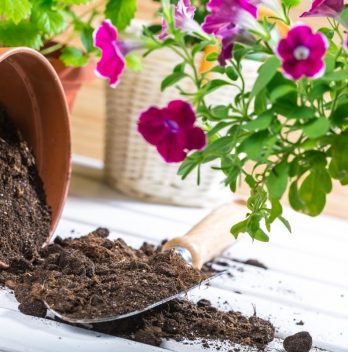Those who enjoy gardening and growing indoor plants need to learn how to sterilize potting
Sterilized and clean
Why Should You Sterilize Potting Soil ?
Sterilizing potting soil is very important!

How to Sterilize Potting Soil
Sterilizing your potting
Materials Required
- Large roasting pan or a baking sheet
- Oven
- Aluminum foil
- Meat thermometer
- Mixing spoon
- Fertile
soil - Water
Black Gold 1311002 8-Quart Seedling Mix
Read more about Gypsum Soil Amendment
Steps to Follow when Sterilizing Potting Soil
- Prepare your
soil for sterilization. Thesoil must be moist enough to be able to compact into a ball. But it should crumble when pressure is removed. This is done by packing a ball ofsoil between your hands and adding a little water. Mix until you get the right consistency. - Place the
soil into the roasting pan or baking sheet. Evenly distribute it in the pan and break anysoil lumps available. Keep thesoil under 4 inches deep and do not fill the edges of the pan. Cover the pan or sheet tightly with a foil. The foil must be tight and secure to prevent moisture loss and thesoil burns. Make a hole in the center of the foil large enough for the meat thermometer to fit in through it. - Start the sterilization process. Set the oven at a low temperature and Place the tray inside. The temperature for sterilization should be 180 degrees Fahrenheit. Temperatures above this may cause burning. Burning the
soil changes the chemical composition of thesoil . The burntsoil will cause harm to plants. Allow thesoil to burn for about 30 minutes at a steady temperature. You must pay close attention to temperature fluctuation to avoid using too high or too low heat.
- Cool your use before using it. After baking for 30 minutes, remove the
soil from the oven and let it sit until it reaches room temperature. To allow heat to escape, carefully lift the corner of the foil. Be very careful as you do this as the escaping steam will be very hot and can cause burns. - Use your
soil . Once thesoil has cooled down and removed from the pan, go ahead and place it in the pot. Remember to sterilize your growing pots too so that they do not infect the newsoil . Plant your seeds no deeper than 4 times the diameter of the seed. Water the sterilizedsoil with a mister to avoid flooding it. Place thesoil and the sown seeds into a cool room, avoid direct sunlight until germination.
Conclusion
Sterilizing potting
FAQs
What shouldn’t use to sterilize soil?
I’ve tried bleach, I used a little bleach to clean up some moldy soil (which had been sitting in a bag for a long time) and then put it in my garden, and it seemed fine. I used one cup of bleach in three gallons of water. It smelled like rotten eggs for a couple days and I had to throw out all of my plants. I would never use bleach again.
I’ve tried soaking it in ammonia, but it didn’t do much. But I don’t think it’s necessary or recommended.
What does work?
The easiest way to sterilize soil is to use a heat gun. This is actually a form of pasteurization, which is much faster than using steam or steam heat. The pasteurization process takes about 3 minutes to achieve a kill of all bacteria, while it would take days for a slow-acting sterilant like ethylene oxide to kill all of them. So, you can kill 99% of the bacteria in 3 minutes. It can be used to kill all kinds of bacteria and fungi. You can also use chemicals, which are usually toxic and will kill the organisms that you want to keep. The most common chemicals for this are chlorinated hydrocarbons. They have a low toxicity and are easy to use. A third option is to use physical methods such as digging up the soil and moving it to another location. Rubbing alcohol can be used as a disinfectant and also as a solvent to get rid of stubborn soil-based disease. Make sure you do not use it in any area with soil that has been previously treated with a fungicide, as it will react with the active ingredient and make the soil unusable. Hydrogen peroxide is another option. A better option would be to use an autoclave, which is a pressurized chamber that kills bacteria, viruses, fungi, and other pathogens.
Why sterilize soil?
Soil contains living organisms.
These organisms include bacteria, fungi, mites, nematodes, protozoa, and viruses. The presence of these organisms in soil is often considered undesirable. For instance, bacteria can cause disease or spoilage in food products.
What’s the kind of mold that I should be worried about?
I’m not sure if you’re aware, but there are two types of mold: “black” and “white”. Black mold is toxic and may cause illness. White mold is not. You can easily tell the difference by looking at the mold, it will be white for “healthy” mold. If the mold is black, it’s probably toxic and you should throw it away.

Brian believes the best days are spent outside with soil on your hands. He finds his rhythm in the details of the garden—from carefully tending to established plants to the excitement of propagating new varieties. A true outdoor enthusiast, Brian is here to swap stories, share advice, and celebrate the rewarding work of growing.





